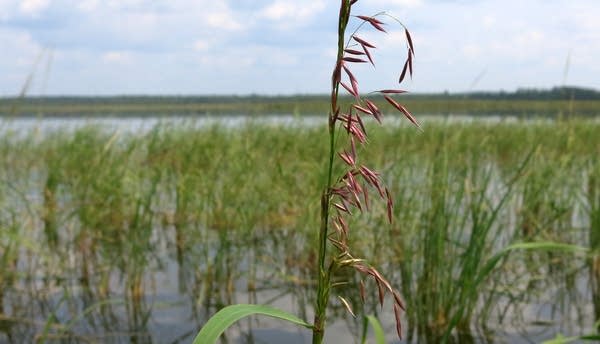Wild rice takes a hit after stormy spring

In a really good year, wild rice beds sprout so dense on Big Rice Lake that it looks like a 3,000-acre wheat field.
But this year wasn't so good.
When Rod Ustipak, Minnesota's resident wild rice, expert dropped by Big Rice recently to take a look at the crop, the best he could say was, "I guess that's okay."
Still, "okay" is a better grade than many lakes will receive this year from Ustipak, who works for the state Department of Natural Resources and Ducks Unlimited managing the state's wild rice program.
Create a More Connected Minnesota
MPR News is your trusted resource for the news you need. With your support, MPR News brings accessible, courageous journalism and authentic conversation to everyone - free of paywalls and barriers. Your gift makes a difference.
There are fewer rice heads in the Big Rice Lake beds, but the crop here is much better than in lakes to the north. In general, Ustipak said lakes from Bemidji to the Canadian border will yield only a quarter of the wild rice they did last year.

This spring, a chain of heavy storms swept through the state, raising water from a few inches to a few feet in lakes.
After backing his truck down a gravel landing on the lake's west side and hopping up on the tailgate with a pair of binoculars to take a look, Ustipak described how a freight train of rain clouds, pushed northern lakes to the brink at just the wrong time for wild rice. Wild rice is a finicky plant, especially in its early life, explained Ustipak from his tailgate perch -- using his dog as a measuring stick.
Mia, Ustipak's six-year-old black lab bolted from the truck as soon as he opened the door and made for the water.
"She's actually a pretty good gauge," he said, "If she's walking, the water's a good depth for rice. If she swims it's too deep."
In places like Rainy Lake, Nature's Lake, and Lake Winnibigoshish, Ustipak said Mia would swim through most beds -- a sign of too much water. Drowned rice in those northern lakes makes up a big portion of Minnesota's crop. Add the wild rice beds in lakes around the state where the harvest will be better, and Ustipak expects a harvest that's 60 percent of last year's.
Ustipak and about 30 locals watch over 103 of Minnesota's most productive wild rice lakes. He pulls his harvest estimates from those lakes, but said wild rice management isn't an exact science.

Unlike corn or wheat, there are no exact yield statistics for wild rice. DNR records list a total of 700 lakes with substantial rice beds. Harvesters only get a small percentage of the crop so total pounds harvested, Ustipak said, is nearly impossible to calculate.
"Some researchers have tried throwing down hula hoops and counting the stalks inside," Ustipak said.
But breaking out the hula hoops across 700 lakes isn't practical. So far, the best measure Ustipak has is to estimate based on the look of each lake.
The Leech Lake Band of Ojibwe keeps a much more exacting eye on their wild rice. Levi Brown, the band's environmental management director said the wild rice outlook is less dire on the reservation.

Heavy rains, he said, flooded some of the largest beds on Winnibigoshish and Leech Lake itself. It's the same trend Ustipak saw from his tailgate. But even without those large beds Brown said inlets and backwaters have plenty of rice for those who know where to look.
"Some of this takes lifetimes to learn," he said.
Wild rice is a big deal on the reservation. The grain figures deeply into tribal beliefs and customs, and as such, is managed as a sacred resource.
On a recent afternoon Brown led a group of guys hefting 50 pound bags of last year's wild rice into a cargo container out behind the Department of Resource Management facility in Cass Lake.
Every year his department buys between 100,000 and 200,000 pounds of green wild rice from band members and ricers within the reservation borders. With harvest closing in, and dozens of locals readying their canoes and rice poles, Brown is racing to make room for the new crop.
"You should see this place during harvest," he said. "Every car has a canoe on the roof. Sometimes three."
Most years the band pays out a total of $500,000 to local harvesters and processors.
Every workable rice bed is watched meticulously by a group of elders charged with discerning the perfect moment of ripeness. Only when the elders sign off is a bed opened to harvesters. Knowledge and history, Brown said keeps rice plentiful on the reservation, even when the largest beds are drowned by heavy rains.